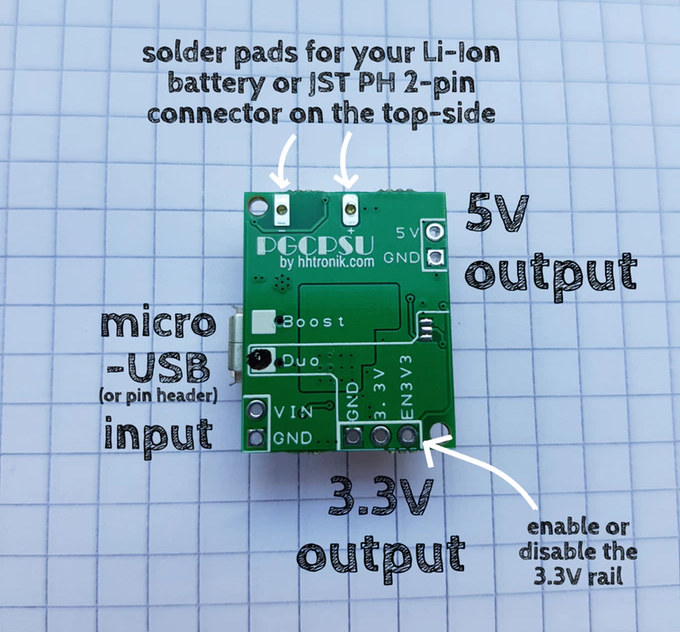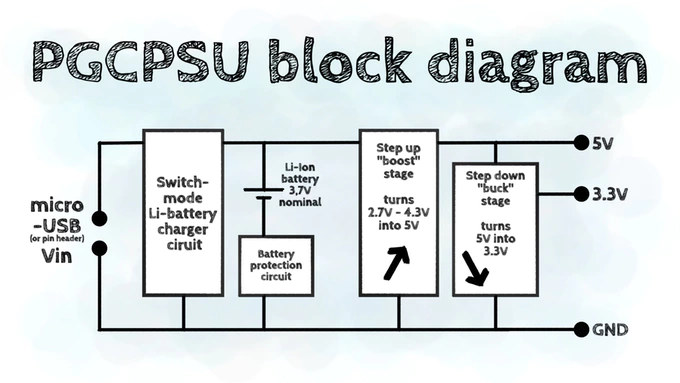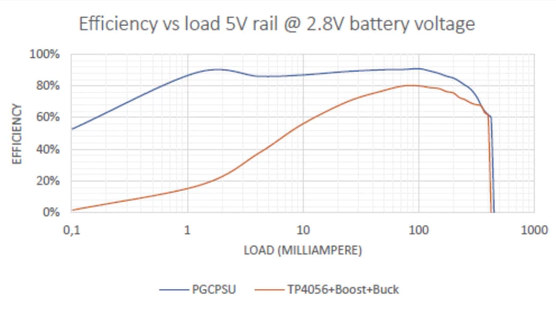Last year we wrote about a two dollars USB 18650 battery shield that allows you to easily power your board over USB using a 18650 LiPo battery. But if you need some more flexibility, and extra features such as reverse polarity protection, PGCPSU, which stands for “Pretty Good Cheap Power Supply Unit”, may be worth looking into.
 PGCPSU key features & specifications:
PGCPSU key features & specifications:
- Power Input – micro USB input or pin header for charging (4.7V to 6V max.)
- Power Output
- 5V rail providing at least 350mA, and up to 650mA
- 3.3V rail providing at least 400mA, and up to 800mA
- Safety
- Integrated battery protection including reverse polarity protection
- Over-discharge, short circuit/over-current protection
- Power Efficiency
- High efficiency even at low load, important for long battery life
- Low quiescent current (49uA for the 5V rail + 57uA for the 3.3V rail)
- Enable/disable pin for the 3.3V rail with selectable default state solder jumper
- Charging – Quick charging at up to 1.9A (fully charges a 2,600mAh cell in about 2 hours)
- Dimensions – 25x20mm
 Staudt Technologies highlights the efficiency of their module by comparing it to a similar design based on off-the-shelf parts such as TP4056 battery charger, or DW01A protection IC, and PGCPSU had a much better efficiency, especially at low loads thanks to the low quiescent current.
Staudt Technologies highlights the efficiency of their module by comparing it to a similar design based on off-the-shelf parts such as TP4056 battery charger, or DW01A protection IC, and PGCPSU had a much better efficiency, especially at low loads thanks to the low quiescent current.
They also reported battery life with a 2,600 mAh battery that is included in some of the kits for different scenarios:
- 3.5 days for Arduino Blinky sketch.
- 17 hours for a Raspberry PI Zero W posting its uptime to a REST API via WiFi
- Over 4 months and still running for an ESP8266 based soil moisture and temperature sensor that is posting a measurement every 10 minutes; same result for an ESP8266 based WiFi / PIR motion sensor
The module can also be used as an uninterruptible power supply.
 PGCPSU has now launched on Kickstarter with a lowly 1,250 Euros funding target. Rewards start at 7 Euros for a PGCPSU DUO (5V/3.3V) module and a PGCPSU Boost (5V only) module, but once all early bird rewards are gone price for PGCPSU Duo is offered for 11 Euros, or you may consider a starter kit with a DUO module plus a 2,600 mAh 18650 LiPo battery. Shipping adds a further 7 Euros, and backers can expect their rewards between May and August 2019 depending on the selected perk.
PGCPSU has now launched on Kickstarter with a lowly 1,250 Euros funding target. Rewards start at 7 Euros for a PGCPSU DUO (5V/3.3V) module and a PGCPSU Boost (5V only) module, but once all early bird rewards are gone price for PGCPSU Duo is offered for 11 Euros, or you may consider a starter kit with a DUO module plus a 2,600 mAh 18650 LiPo battery. Shipping adds a further 7 Euros, and backers can expect their rewards between May and August 2019 depending on the selected perk.

Jean-Luc started CNX Software in 2010 as a part-time endeavor, before quitting his job as a software engineering manager, and starting to write daily news, and reviews full time later in 2011.
Support CNX Software! Donate via cryptocurrencies, become a Patron on Patreon, or purchase goods on Amazon or Aliexpress





I’m surprised ESP32 etc boards haven’t just integrated a cheap PMIC already. You’d get all of the features of this + a bunch of software controllable rails that you can power up on demand.
The graph suggests this maxes out at 0.4A, but you really do need 2A for a raspberry pi 3B+ at peak, so it would be nice if there was a higher spec version.
Hi Paul,
Yannic here, I’m the creator of the PGCPSU. Honnestly the full blown RPI wasn’t a design target, especially as there are a bunch of Boost converters you could use for that coming from China at really low rates.
Plus, due to the rather high base supply current necessary for a “big” RPI, the low quiescent current part of our PSU is really not that relevant. It’s really not what we were targetting in the first place.
Have a nice evening
Yannic, you should probably partner with Robert Murray-Smith send him some units and create a version that can be used directly with his diy supercap/batteries testing preferably with generic long term wifi logging for the mass exposure and later sales to the diyers https://www.youtube.com/channel/UC4AkVj-qnJxNtKuz3rkq16A
A little typo: it’s ESP8266, not ESP8622.
While it’s nice that they focus on conversion efficiency, the TP4056 has nothing to do in this since it’s the charging circuit.
What matters is the boost part behind only. For the miniature battery I always have in my pocket ( https://wtarreau.blogspot.com/2017/12/tiny-usb-batteries-v3.html ) , I used a TP5410 which is able do deliver up to 2.8A under 5V (measured) and has a very low quiescent current around 10 µA or even less if I remember correctly. I’ve verified that the 240mAh battery is still usable after 2 months. This chip does both the charge and the boost, so it’s a space saving and cost-saving solution. What is very important is to have a good quality inductor, as I noticed that some devices didn’t reliably work with certain inductors (too many losses).
>For the miniature battery I always have in my pocket
Do you have asbestos lined pockets?
Hi Willy,
Yannic here, I’m the creator of the PGCPSU. I didn’t get my hands on a TP5410 for now, and while it seems to be a nice little beast, its clearly targeted at implementing small “power bank” type devices. While I can’t find any good description about that in the chinese only datasheet I found, many of these chips don’t provide continuous supply until loaded with a few mA.
Our primary goals with the circuits involved in PGCPSU were to provide stable regulation (down to the range a uC in deep sleep consumes e.g. a few ten uC often) as well as fast charging (more than the ~1A that a linear charger in a SOIC-8 package can deliver).
Regarding your indication about “the TP4056 has nothing to do in this”, I suspect that you’re reffering to the legend in the efficiency charts. We just reeused that legend througout the charts I think, we may should have written something along the lines of “the other combo” or “random boards” perhaps.
If you’re actually willing to take a few minutes (and if components are available) I’d be really thrilled to know the current draw of that TP5410 module when loaded at like 100uA and 1mA as well as how well they regulate at these loads.
Best regards,
Yannic
I can check, I think I still have one or two of these modules unmodified (I’m not going to disassemble my finalized battery, I’d miss it if I damaged it). Note, for my use case I only care about low idle current when not used at all (i.e. battery in pocket or lying on the shelf). I agree that for a uC it’s different. I’ve noted that a number of these modules are poorly regulated under low load. I’ve seen some converters emit anything between 3.5 and 5V when idle.
With this said, the real value of your module is that it will be seen as a cheap UPS. This is why people are asking for more current to power their RPi. And with your fast charger delivering almost 2A, it’s very tempting to consider placing this between any wall adapter and 5V device!
Been done before Willy ?
https://www.etsy.com/listing/246719534/fuel-micro-charger-2-micro-usb-the
I saw this one after my initial attempts, however it doesn’t provide enough juice to turn on my bike’s light. It requires 1.6A on start-up, after which I can half the power if needed. The vast majority of these adapters cut off when facing this. It’s still not powerful enough to power a soldering iron though, I need to continue the research 🙂